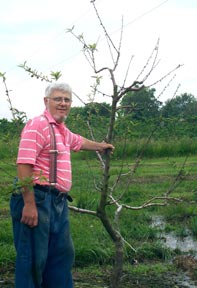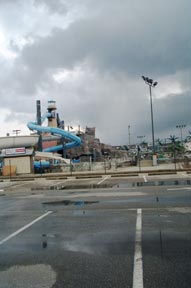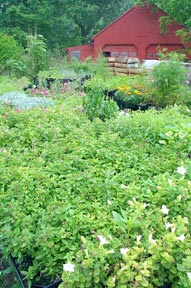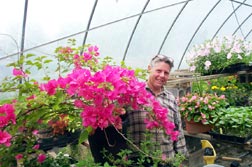
|

People in Bay Country are miserable. They’re fed up with five weeks of weather forecasts announcing rain, chance of showers, partly cloudy, chance of thunderstorms, severe storm warning. One day of sunshine isn’t enough to balance the clouds.
“It’s unlike anything we can remember,” says Lisa DiGiacinto of Anne Arundel County Recreation and Parks. “There’s been no weekend since March without some rain. The good news is that the parks are very green. But conditions on the ball fields have created havoc with our leagues.”
Anne Arundel adult and youth baseball and softball teams, as well as boys’ and girls’ lacrosse teams, have had to practice when and where they can. Back in March, piled-up snow forced them into parking lots. Now, it’s not just rainy days that keep them out of the fields. For days after each rain, the ground is too wet and soggy for play.
“Some parks drain better and recover faster than others,” says DiGiacinto, “but there’s no park that hasn’t been affected. Usually parents and coaches get irritated when they can’t play, but now they’re past that stage. Now, it’s just something to laugh about.”
On the job in Anne Arundel county, DiGiacinto juggles up to 250 games of baseball, softball and lacrosse to schedule — and reschedule or cancel — each week in over 200 community parks. She says flatly, “We don’t have much hair left over here.”
The Good News
Groundwater levels are indeed higher than last year, U.S. Geological Survey statistics confirm. Like DiGiacinto, we all know how soggy the ground is under our feet. The Geological Survey goes deeper, monitoring the underground rivers that feed our wells.
In April, 2002, the survey announced “Drought in Full Bloom: Low Water Levels Result in Water Restrictions.”
At this time last year, all but one well was below normal levels and many set monthly record lows. The drought was in ebb by December, as spokeswoman Wendy McPherson explains: “For the first five months of 2002, 45.8 billion gallons of fresh water per day flowed into the Bay, with 83 percent from the Susquehanna, Potomac and James rivers. For the same five months this year, the flow rate is double at 92.1 billion gallons per day. That’s 36 percent above normal. We have recovered substantially from last year’s drought conditions though we don’t yet know the long-term implications.”
By late May, “the groundwater was saturated.”
 |
photo by Kerry Culbertson
Horticulturalist Frank Gouin’s peach trees have suffered with too much rain and wet weather. |
On the Farm
The dry conditions of the last few summers were a disaster for farmers. All this rain is a good thing, but perhaps too much of a good thing.
“Look at the size of the peaches. They are already golf-ball size, about two weeks ahead of usual,” enthused Frank Gouin, retired University of Maryland professor of horticulture, who single-handedly farms seven acres at Upakrik Farm. “Last year,” he reports, “I lost 40 percent of my Canaan firs. You can see the advantages of the rain.”
The peaches will be big but not so sweet this year. Drought is good for sweetness but not for size. That’s not a big problem. It is a problem, however, that with all the standing water in the orchard, Gouin has lost six of his peach trees after a seven-year investment.
On a daily basis, rain-fueled rapid growth keeps Gouin busy with thinning the peaches, as he must to bring the crop to market size. He used an ordinary toilet brush to knock at least half the flowers to the ground last month. Now he goes through the orchard at intervals to knock down half the fruit, allowing for maximum growth of each peach by maintaining three to four inches in between.
There’s more weeding, too. Gouin explains, “Herbicides don’t work as well. So much water inactivates the herbicide, so I’ve had to go twice under the peach trees.”
We’ll get to taste the summer’s crop when early varieties are harvested starting around the Fourth of July. Others will come in, as usual, in August.
As for the other crops, Gouin itemizes the good and the bad: “Potatoes all rotted but for eight plants. Broccoli, peas, carrots and onions love it when it’s cool. But the corn I seeded hasn’t come up.”
Gouin’s neighbor Lenny Baumgardner adds that in his sandy soil just across the way, “potatoes are doing great but my pea vines got so high that they rolled over.”
Gouin continues his inventory. Primary-cane raspberries — a new variety developed by his colleague at University of Maryland Harry Schwartz — are growing tall with no need for staking. “It’s an ideal season for rhubarb,” Gouin adds. “Mosquitoes are no worse than usual this year but it’s never bad here. Grass is growing faster this year and it’s difficult to keep up. I always cut high. Cut it tall and let it fall. You never need to fertilize.”
Gouin points to another plant that loves the wet weather. The fruit, formerly known as Chinese gooseberry, became a popular supermarket staple when it changed its name to kiwi. “I’ve never had it flower the way it has this year,” says Gouin. “The flowers are all on the new wood. It’s hardy in this climate. The flowering bush is the male plant. It fertilizes the female plant that will bear the fruit. The leaves are different on each one.”
 |
photo by Sonia Linebaugh
Wet weather has kept Chesapeake Beach Water Park closed past Memorial weekend and into June. |
At the Pool
The plants are as numerous and as welcome to Gouin as children are at the Chesapeake Beach Water Park. But there, the excess of this spring’s rainwater postponed water play.
Michelle Jenkins is Chesapeake Beach town clerk and general manager of the town-owned water park. “We didn’t open at all on Memorial weekend, our first of the season,” says Jenkins.
“Last summer we had our best year ever, with 800 to 1,000 visitors on a good day,” she says. “This year, the park will open on weekends when weather permits but won’t open weekdays until June 20. That’s because with all the snow days this year, our lifeguards are still in school.”
That’s a weather problem left over from winter.
It’s Jenkins’ job to close the park when weather threatens. “It’s one of my hardest decisions,” she says. “We check every tv station and look at the storm radar on the Internet. If it looks like a small line of rain, people can wait it out in the community center. But if it’s a thunderstorm, we close down.
“We’ll give a full refund if they’ve been here less than three hours. I hope the sun decides to come out.”
On the Bay
Bill Goldsborough of the Chesapeake Bay Foundation also has a job that revolves around water. But the continued rain brings him a different set of concerns.
“Spring rains,” says Goldsborough, “bring greater runoff of anthropogenic [human origin] nutrients like nitrogen and phosphorous that spike the Bay with fertilizers, stimulating plant growth and over-enriching the system — strangling the Bay.”
Fertilizers work the same in the water as they do on land, but on water the results spell disaster. “The three-year drought meant a lot of processes slowed down,” Goldsborough explains. “We saw how the Bay can bounce back from years of accumulated materials, but the current blooms of algae shade the water. Turbidity [cloudiness] is the first effect. That causes the more deadly loss of dissolved oxygen.
“All through the summer, the rockfish, blue crabs and oysters need oxygen just like we do. But there are sections of the Bay that become anoxic [without oxygen] and that will not support aquatic life. It starts in deep water and sloshes into more shallow water where the crabs live and where the watermen put out their pots.”
Goldsborough explains how this anoxic condition affects the blue crab harvest. “If, for instance, there is wind from the west for several days in a row, the lee side will feel it first,” he says. “The watermen will have a boon as the crabs are driven ahead of the moving dead water into their pots.
“Then crabs will become scarce as they are driven into even shallower waters. Then the watermen will find nothing but dead crabs in their pots. Lastly, the crabs will get driven out of the water in a search for oxygen.”
That’s what is called a ‘crab jubilee,’ but it’s not a celebration. It means the crabs are miserable. According to Chesapeake Bay Foundation, crab jubilees happen in the Bay with increasing regularity.
Bay Weekly columnist Chris Dollar, also of Chesapeake Bay Foundation, puts the problem in perspective. “The big message is the Bay doesn’t have the natural buffers it had 200 years ago with the filters of oyster reefs, forest, wetlands and bogs. Sediment runs off too fast, and the Bay becomes overwhelmed.”
Though Bay-damaging nitrogen in runoff comes from many sources, including agriculture, sewage treatment and air pollution, homeowners cumulatively add to the problem with over-use of home and garden fertilizers. According to Dollar, the nitrogen that was held in the soil during the drought is, with this spring’s heavy rainfall and increasing groundwater, running into the waterways at increased rates. Dollar cites Rockhold Creek, which empties into the Bay near Deale, for its worst algae bloom in 20 years.
On the plus side, private septic systems seem to be seeping less sewage into Bay waters. According to Annapolis Septic and Cleaning Service, the main problem this year is access “because driveways are sinking,” says owner Dick Gessford. “Rain hasn’t made much difference in the number of calls. There aren’t many old systems left.” The newer systems seem to be doing their job.
 |
photo by Sonia Linebaugh
Green and growth abound, but blooms are far behind. |
In the Garden
The other good news is that private gardens won’t need much encouragement — only the sun — to produce this year. Betty Knapp of Lochless Farm in Owings tells us that strong root and leaf now will lead to profuse flowering once the sun has a few days to work its magic.
Though plants like petunias and geraniums don’t like the rain and remain flowerless, their leaves are thick and green. Knapp predicts that with their well-established roots, a few days of sun will put them in vigorous bloom. In the greenhouse, it’s a different story. Inside, petunias match the flowering bougainvillea for showiness and Knapp complains that they’ve attracted hummingbirds inside.
Gardeners haven’t gotten their plants in yet this year, says Knapp. “In between showers, people are coming to buy, but business is slow. If you can’t plant, you don’t buy. We aren’t even plowed for our own garden yet. We’ll do it as soon as we get a few days of sun in a row.”
Knapp advises that it’s not too late to plant. With the cooler temperatures, there’s still time to get started. At Lochless, “the tomato plants are growing real good. You may have to wait until almost August until you can pick tomatoes, but when they start, they’ll be real good. The bees just have to have a few days of sun to do their thing. There’s so much groundwater that once they start, plants will hold up longer than last year.”
 |
photo by Sonia Linebaugh
Betty Knapp’s plants flourish — in the greenhouse. Outside all is wet, soggy and unplowed. |
The rain has also kept insects under control at the farm. “I’ve seen some cucumber beetles, but not a whole lot of egg-laying,” says Knapp. Mosquitoes haven’t been a problem yet, but Knapp predicts they will be plentiful once the rains stop.
Though her business is with garden plants, Knapp also lives among fields. “People with hay have problems,” she says. “The first hay-cutting is a big problem this year. The ground is so wet that it’s out there growing but nothing is drying so it can’t be cut. The alfalfa is getting overgrown, too.”
But, says Knapp, “I don’t want to complain. I can handle the water better than the drought. The sun was out for about four minutes at 10 o’clock today, but not four minutes right in a row. Then it was hot.”
From Partly Cloudy to Partly Sunny
On June 2, a sunny day broke the discouraging pattern of showers, rain, thunderstorms and partly cloudy.
To the National Weather Service, our weather is no big deal. With recent tornado activity in the Midwest, continued drought in the West and flood warnings in several Southern states, the fact that Bay area temperatures feel more like early May than early June and we’re suffering through more rainfall than usual stirs not more than a yawn on the national weather scene.
Bay residents may be feeling under the weather, but we’ll get over it. Today, or maybe tomorrow, the sun will come out.
About the Author:
Sonia Linebaugh credits development of her writing and related skills to her years as a New Bay Times writer, assistant editor, graphic designer and illustrator. Today she is a freelance writer, artist and teacher, who lives with her husband near the Bay. Her first book, At the Feet of Mother Meera, will be out this fall. |
 |
|
|







